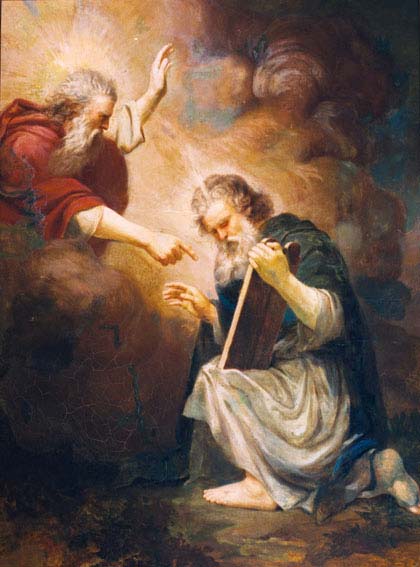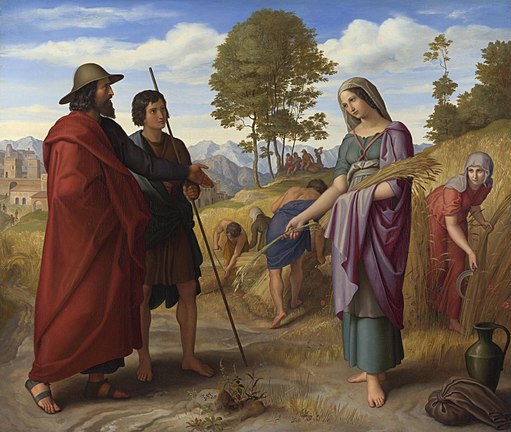A celebration of divine coupling.
A countdown of 50 days.
And a lot of cheese.
Welcome to Shavuot, the holiday that celebrates it all.
- What is Shavuot?
- What does Shavuot mean?
- What are the origins of Shavuot?
- How do you celebrate Shavuot? What are the rituals and traditions of Shavuot?
- When Is Shavuot?
What is Shavuot?
Shavuot (also known as Shovues, the Feast of Weeks or Pentecost in English) is a Jewish holiday that marks the wheat harvest in the Land of Israel, and also commemorates the anniversary of the giving of the Torah (the Hebrew Bible) by God to the Israelites at Mount Sinai.
So the Feast of Weeks is significant for both religious and agricultural reasons.
The holiday occurs on the 6th day of the month of Sivan, which is the third month in the Hebrew calendar. This means that the holiday is usually celebrated during May or June.
Shavuot is traditionally celebrated in the Land of Israel for one day and in the Diaspora for two days.
During the existence of the Jerusalem Temple, it was one of the Three Pilgrimage Festivals. The Three Pilgrimage Festivals are three major festivals in Judaism (Passover, Shavuot, and Sukkot), when the ancient Israelites living in the Kingdom of Judah would make a pilgrimage to the Temple in Jerusalem, as commanded by the Torah.
What does Shavuot mean?
In Hebrew, the word Shavuot means “weeks”. This seems like a weird name for a holiday, doesn’t it?
But there’s a good reason for this name.
Starting the second day of Passover, a special counting begins – Counting of the Omer. The Torah mandates that 7 weeks should be counted starting on that day. The 50th day after Passover (that turns out to be the day after the Counting of the Omer ends) is the holiday of Shavuot.
Shavuot has two meanings – spiritual and agricultural.
The spiritual meaning is the celebration of receiving the Torah from God.
During the journey from Egypt to the Promised Land, the Israelites reached Mount Sinai. It is there that Moses received the Ten commandments, the first ten rules that define the relationship between the Jews and God as well as between the Jews and themselves. And it is there that the Israelites received the Torah, where God devotes himself to the Jews as “the chosen people”, and the Jews pledge their loyalty to God in return.
This event is one of the defining events of the Jewish people and the Jewish history.
The idea of counting each day from Passover to Shavuot represents spiritual preparation and anticipation for the giving of the Torah, and demonstrates how much a Jew desires to accept the Torah in their own life.

The agricultural meaning is that the holiday marks the wheat harvest in the Land of Israel. The Feast of Shavuot is the season of the grain harvest, specifically of the wheat, in the Land of Israel. In ancient times, the grain harvest was a seven week long season of gladness. It began with the harvesting of the barley during Passover and ended with the harvesting of the wheat on Shavuot.
So you can say that Shavuot was the concluding festival of the grain harvest, and during the existence of the Temple in Jerusalem, an offering of two loaves of bread from the wheat harvest was made on Shavuot.
That is why the holiday is also known as the “Festival of Reaping” or “Feast of Harvest” (“Chag HaKatzir” in Hebrew).
The holiday was also the first day on which individuals could bring the Bikkurim (first fruits) to the Temple in Jerusalem, giving it the name “Day of the First Fruits” (“Yom HaBikkurim” in Hebrew).
What are the origins of Shavuot?
The feast of harvest is mentioned in the second book of the Hebrew Bible, the book of Exodus. In Exodus 23:16 it says:
“and the feast of harvest, the first-fruits of thy labours, which thou sowest in the field”
The feast of weeks is also mentioned in the book of Exodus. In Exodus 34:22 it says:
“And thou shalt observe the feast of weeks, even of the first-fruits of wheat harvest, and the feast of ingathering at the turn of the year.”
The holiday is also mentioned in the fourth book of the Hebrew Bible (Numbers 28:26) and the fifth book (Deuteronomy 16:10).
How do you celebrate Shavuot? What are the rituals and traditions of Shavuot?
On Shavuot, the rabbinic observances for the holiday include reciting additional prayers, making Kiddush, partaking of meals and being in a state of joy, as well as abstaining from work.
There are some other fun and tasty customs as well:
During the morning synagogue services of the holiday, a liturgical poem (called piyyut) is called. The poem praises the greatness of God, the Torah, and Israel.
On the holiday it is customary to consume dairy products like milk and cheese. So on a typical holiday you can expect many delicious foods – cheesecakes, cheese blintzes, cheese kreplach (which are basically cheese dumplings), cheese sambusak (like cheese samosa), cheese ravioli and cheese-filled pancakes to name a few.
On Shavuot, a special scroll (“Megilla” in Hebrew) is read in the synagogues – the Book of Ruth. The book tells the story of a Moabite woman named Ruth and her accepting of Yahweh, the God of the Israelites, as her God as well as the Israelite people as her own. This is just like the Israelites did in Mount Sinai, when they accepted the Torah. Another fun fact connecting the Book of Ruth to the holiday is the fact that King David, Ruth’s descendant, was born and died on Shavuot.
Some Jews have a romantic view of the holiday – as if it were a wedding! On this day, the matchmaker Moses brought the bride (the nation of Israel) to the chuppah of Mount Sinai to marry the bridegroom (God), and the Torah is the marriage contract (the ketubah).
This is why some synagogues decorate the platform of the synagogue with a canopy of flowers and plants so that it resembles a chuppah.

There is practice of staying up all Shavuot night to study Torah (a Torah-thon). The reason for this is that Moses had to wake up the over-sleeping Israelites on the day of receiving the Torah, as God was already waiting on the mountaintop. To rectify this perceived flaw in the national character, many religious Jews stay up all night and learn Torah.
Even today, in secular agricultural communities in Israel (such as kibbutz), the holiday is celebrated as a harvest and first-fruit festival that includes a wider, symbolic meaning of joy over the accomplishments of the year.
As such, not just agricultural produce and machinery is presented to the community, but also the babies born during the preceding twelve months, in a festival called Bikkurim (Hebrew for first-fruits).
So that sums it up – the celebration of the divine coupling of God and its people, with a bonus of a lot of cheese. Well, it’s a bonus assuming that you’re not lactose intolerant…
When Is Shavuot?
2021 – begins in the evening of Sunday, 16 May and ends in the evening of Monday, 17 May
2022 – begins in the evening of Saturday, 4 June and ends in the evening of Sunday, 5 June
2023 – begins in the evening of Thursday, 25 May and ends in the evening of Friday, 26 May
2024 – begins in the evening of Tuesday, 11 June and ends in the evening of Wednesday, 12 June
2025 – begins in the evening of Sunday, 1 June and ends in the evening of Monday, 2 June

